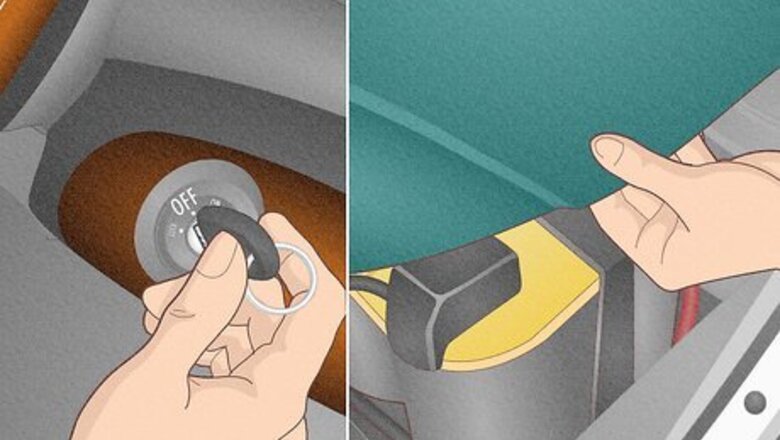
views
- Protect yourself with utility work gloves and safety goggles.
- Disconnect the negative terminal first, then the positive terminal.
- Set aside 10-15 minutes to disconnect the battery, another 10-20 minutes if you need to remove corrosion, and another 10-15 minutes to put it back or install a new one.
- Reverse the original order and reconnect the positive terminal first, then the negative terminal.
Disconnecting the Battery
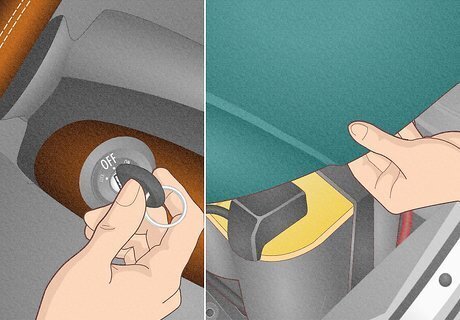
Turn off the ignition and open the hood. Always turn your car off before you disconnect the battery to reduce the risk of electrocution. Then, look inside your car for a lever to pull that will release the hood latch. Check the side panels near the floor around the driver's seat—that's usually where it is. In some cars, the battery is actually under the passenger seat or in the trunk. If you're having a hard time finding your battery, check your owner's manual. If you've just been driving, wait 20-30 minutes for the engine and battery to cool before you get started.
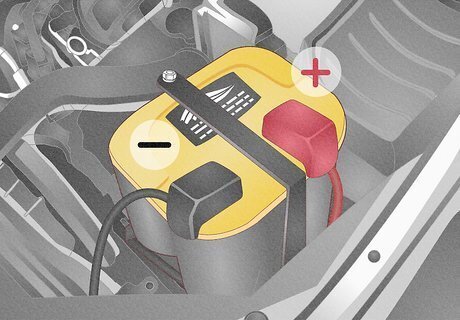
Locate the battery and identify the positive and negative terminals. The battery will be a big block with cables coming out of it. Typically the terminals are covered with plastic caps that make it really easy to tell the terminals apart—the positive terminal is covered with a red cap and the negative terminal has a black cap. If the plastic caps are no longer there, look for the "-" symbol to indicate the negative terminal. The "+" symbol indicates the positive terminal. Suit up with safety goggles and utility work gloves to protect your eyes and hands. If you're wearing rings or bracelets, it's a good idea to take those off too—it helps reduce the risk of electrocution.
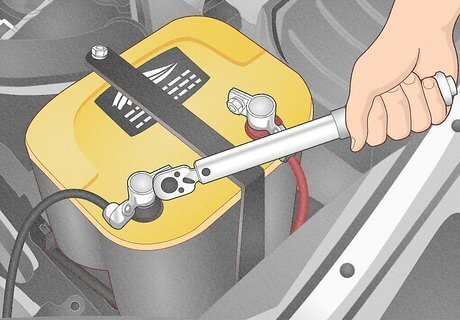
Loosen the nut on the negative terminal. If you have a socket wrench set handy, compare the sockets to the nut until you find the right size. If you don't have a socket wrench set, no problem—a small adjustable wrench will usually do the trick. It shouldn't take more than 2 or 3 counter-clockwise turns to loosen the nut enough that you can take the terminal off. You don't need to remove the nut completely.
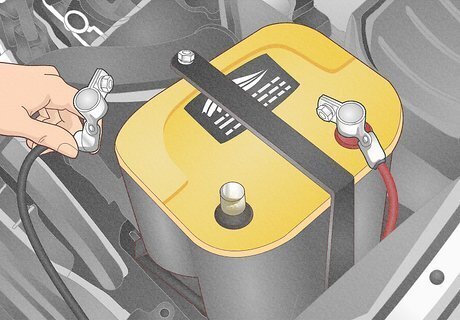
Remove the negative terminal cable. If there's a lot of corrosion, wiggle the connector around a bit to get it free. Then, push the cable back and away from the battery tray so it won't accidentally reconnect with the battery. If the cable keeps springing back, cover the metal terminal connector with tape. That way, it won't make a connection even if it does happen to touch the battery.
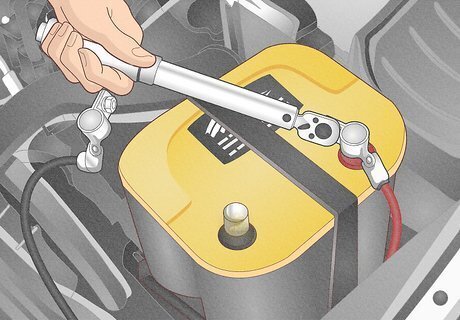
Repeat the same process with the positive terminal. Loosen the nut on the positive terminal and wiggle that bracket around until you can pop it off. Then, push it back away from the battery. Your battery is officially disconnected!
Removing and Maintaining the Battery
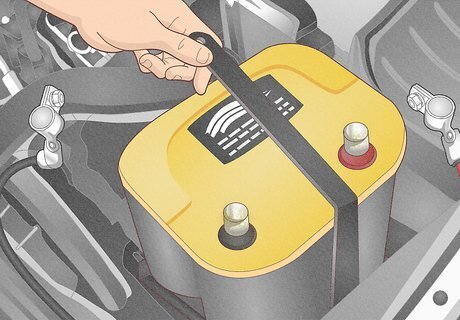
Take off the bracket that holds the battery in place. Check out how the bracket works—sometimes they just snap on. If it has nuts, use the same wrench you used to loosen the nuts on the terminals to remove the bracket. Set any parts you've removed somewhere safe away from the car—you don't want them falling down into the engine bay where it would be a pain to get them out.
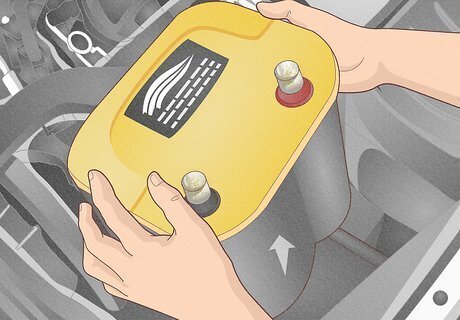
Lift the battery straight up out of the tray. Raise the battery with both hands, keeping it upright and level as you move it. Car batteries have liquid battery acid inside—if it sloshes around it could leak out and cause burns. If you've never handled a car battery before, give it a little test lift first so you can make sure you've got a good grip—at 30 to 50 pounds (14 to 23 kg), they're heavier than they look!
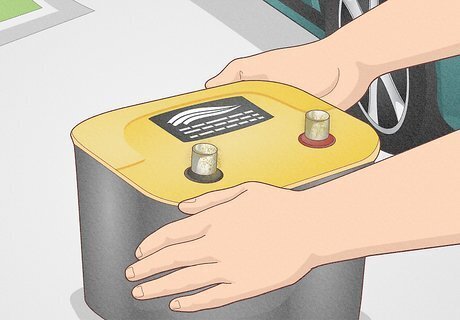
Set the battery on a flat surface away from the car. Keep the battery level and set it down gently. If you're replacing an old battery with a new one, set the old one down right next to the new one so you can make sure they're both the same size.
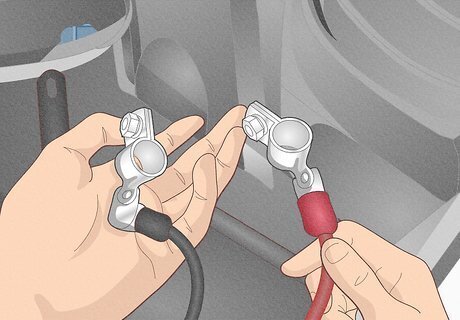
Inspect the cables for cracks or other damage. If the rubber casing around the cable is cracked or frayed, it needs to be replaced. Your local auto parts store will likely have the part you need. If they look fine, just give them a good wipe with a rag or towel so they're clean.

Clean the corrosion off the terminals with baking soda. Get a plastic cup of tap water and dissolve 1 teaspoon (7 grams) of baking soda in it. Then, pour it over the terminals and use an old toothbrush or round wire brush to scrub away the corrosion. If there's a lot of corrosion, let the baking soda solution sit for about 5 minutes to penetrate before you start scrubbing. If you're putting your old battery back in the car, do the same thing with the posts on the battery so everything is clean and corrosion-free. Once the terminals are clean, dry them off and apply a layer of petroleum jelly or anti-corrosion grease to keep future corrosion at bay.
Reconnecting the Battery

Set the battery in the tray so the terminals line up. Lift the battery with both hands (or use the handle, if it has one), keeping it level, and set it down gently. Check that the positive battery post is on the same side as the positive terminal.
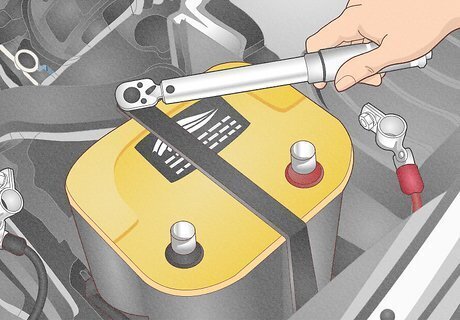
Screw the bracket back in place over the battery. Get that bracket you took off to remove the battery and line it up so you can fit the screws or nuts back in place. Then, use the same wrench you used to remove it to put it back. You might be tempted to just leave it off, but the bracket helps reduce the vibrations that can cause your battery to die faster.
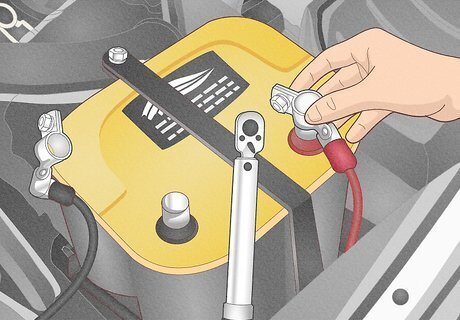
Connect the positive terminal to the positive post on the battery. Reverse the process of disconnecting the battery, connecting the positive terminal first. Fit the connector over the post and hold it down so that it sits flush against the battery. Then, use your wrench to tighten the nut with clockwise turns. As a rule of thumb, if there's ever just one terminal connected to your battery at any time, it needs to be the positive one.
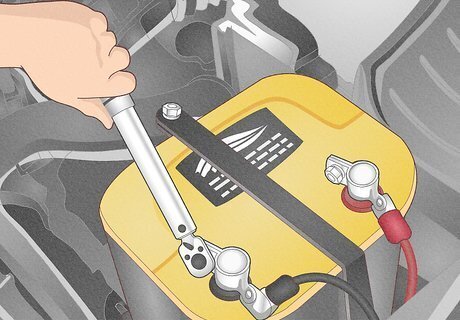
Connect the negative terminal to the negative post on the battery. Now you're ready to connect the negative terminal. Set the connector over the negative post on the battery and tighten up that nut so it stays in place.
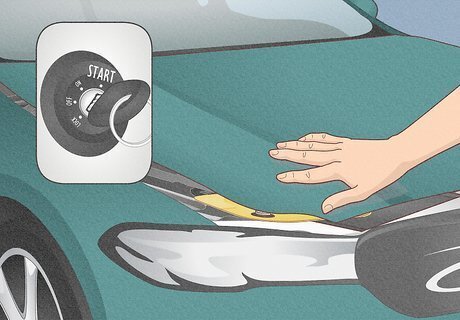
Close the hood and start your car. That's it, you're done! Get in your car and turn the key in the ignition—your car should start right up. Since you disconnected the battery, you'll have to reset the digital clock on your display. You'll probably have to adjust your other settings as well, so it might take a couple of minutes to get everything back the way you like it. When you first start up your car, you might notice that it idles rough. Don't worry, this is normal and due to the loss of battery power. After a few minutes, it'll be fine.

















Comments
0 comment